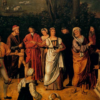Book Review: Churches, Cultures & Leadership: A Practical Theology of Congregations and Ethnicities
Mark Lau Branson and Juan Martinez, Churches, Cultures & Leadership: A Practical Theology of Congregations and Ethnicities. IVP Academic, 2011. $25.00.
A friend of mine was recently asked to take charge of the childcare ministry of her ethnic church. This ministry had long frustrated her, so she saw this as a great opportunity to implement reform. She decided to send out a survey to the church to see what areas of improvement were most needed. She was surprised by the response: The English-speaking congregation responded with all the same criticisms and frustration that she felt. However, the immigrant congregation responded with glowing reviews and positive feedback for that ministry. Change was not going to be as easy as she had hoped.
As many of our communities grow increasingly diverse, it should not be surprising that the same diversity is being reflected in our churches. As the gospel is preached to all, it is powerful to bring together those who otherwise have nothing in common. And yet, having brought these people into a church, how are we to pursue unity among such diversity? What does leadership in a culturally diverse context look like? These are the sorts of questions that Mark Lau Branson and Juan Martinez attempt to answer in Churches, Cultures & Leadership.
This book is split up into three parts. The first is “Theology and Context.” It engages the Bible’s teaching on the importance of diversity and culture. The second part, “Sociocultural Perspectives,” gives a number of different categories for understanding cultural differences. The third part, “Leadership, Communication and Change,” describes how to lead a church to and through greater diversity.
CRITIQUES
The biggest weakness of this book is that it fails to make the gospel the center of church unity. There are discussions of many good topics: God’s purpose in crossing borders (35-37), the role of Scripture and creeds (43), the importance of mission (64-67), and more. But none of them get at the main thing: the unity of the local church is grounded in what Christ has accomplished in the gospel.
Granted, this book is not meant to be a theological work on justification or the atonement. But the gospel has huge implications for how we relate to one another in the midst of our diversity. What difference does being created in God’s image make? How does knowing our sinfulness foster humility? How does the cross transform our relationships? What fruit do repentance and faith bear in relationships across cultural divides? By assuming the gospel, the authors failed to draw on the one thing that distinctly unites Christians to one another.
Another significant weakness is in their definition of a church. The Bible makes no promises as to whether we’ll find unity outside of the church. But inside the local church, God promises to be at work in the lives of his people to display his power. Therefore, in a book on congregational unity, it really matters that we rightly understand what the church is.
The clearest definition the writers give of a church is “a group of people who regularly, face-to-face, come together for worship, learning and caregiving, and live in their own context with concerns for witness and good works” (60). That’s not a bad start. But the problem is, it’s only a start.
What differentiates a church from a small group, or a campus meeting, or a denominational gathering? It’s clear from the introduction and the case studies throughout the book that the authors are drawing from many theological traditions, all of which might have a different understanding of what a church is. Unfortunately, there is little interaction with these different understandings, implying that they are equally valid or that the differences don’t matter.
WHAT’S HELPFUL
Given these critiques, is there anything in this book that is helpful? Definitely.
The most helpful part of the book is the second section, which explains how cultural worldviews work, and then walks through a number of categories of worldview differences. For example, in the chapter on social relations, Martinez walks through the following categories of differences in how cultures view social relationships:
- Hierarchy and equality (136)
- How people form social groups (140)
- Social obligations among friends, rich/poor, and so on (141)
- How people define friendships and personal relationships (144)
- The value of being liked (146)
- How people resolve conflict or problems (146)
- Informal and formal ways people relate to one another (148)
- The value of competition and cooperation (149)
- Societal roles (151)
For each one, he unpacks how American culture differs in these areas from other cultures, illustrating these differences with stories from different churches. In addition to social relationships, the book also elaborates on issues of communication, identity, and even perception and thinking.
This could be hugely helpful for a pastor who is encountering cultural diversity and finding himself mis-communicating with his people. Working through this section might introduce a pastor to new categories to understand cultural differences and expose him to his own culturally-loaded ways of thinking that he wasn’t even aware of.
TWO REFLECTIONS
In reflecting on this book, two observations stood out to me. First, this book highlights for me the importance of humility in a multi-cultural church. In describing different patterns of thinking within cultures, the authors do a good job of revealing blind spots.
The problem with blind spots, of course, is that we’re not aware of our assumptions, even while we order our lives around them. One side cares about efficient problem solving and personal success, while the other side is offended at how little attention is being given to personal relationships or family obligations. In most cases, both sides of a cultural divide have good, godly desires, as well as weaknesses and temptations. Therefore, what’s needed throughout a congregation is a huge dose of humility. Rather than automatically concluding that people are in sin, we should humbly work toward a mutual understanding of the cultural differences beneath our disagreements.
In a church with multiple cultures represented, it would be humble and wise for those in the majority culture to recognize there’s always more they can do to accommodate other cultures. And likewise, those in minority cultures would demonstrate a godly humility by being willing to sacrifice and extend grace in order to be part of a church where they are not the majority culture.
Second, in all the cultural differences that explained and illustrated by the book, it’s clear that there really is no one-size-fits-all model for cultivating unity in diversity. The New Testament does give us many commands on how we are to structure our churches. Church membership and discipline, qualifications for elders and deacons, baptism and the Lord’s Supper—all these are essential for the health of a church. Yet within and surrounding these things, there are still countless opportunities for misunderstanding and conflict. What’s needed is case-by-case, Spirit-empowered wisdom.
This is all the more reason why there must be a theological basis for our unity. Though God does not provide an organizational structure that can solve all of our differences, he provides something far better: the finished work of Jesus that unites us into one Body. As Bonhoeffer said, “Christian brotherhood is not an ideal which we must realize; it is rather a reality created by God in Christ in which we may participate.”[1]
CONCLUSION
If you’re looking for a book that explains how cultural differences might play out in the context of the local church, this could be a very helpful resource. That’s not because being cultural savvy itself is the key to unity. The gospel unites us. But compelled by the gospel, we want to do all we can to pursue mutual understanding and love.
[1] Dietrich Bonhoeffer, Life Together: The Classic Exploration of Christian Community, trans. John W. Doberstein (New York: HarperCollins Publishers, 1954), 30.









